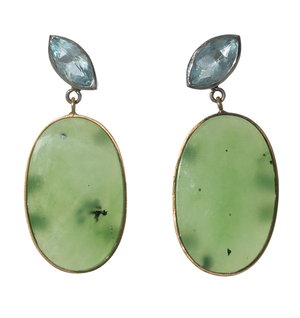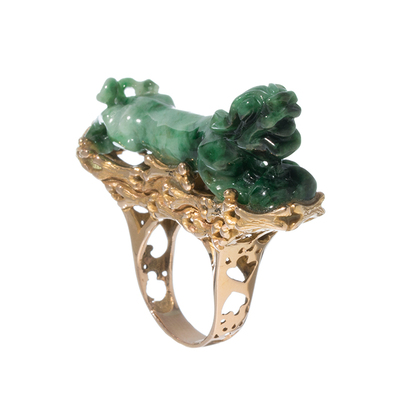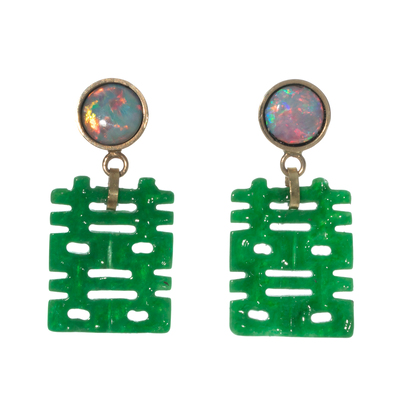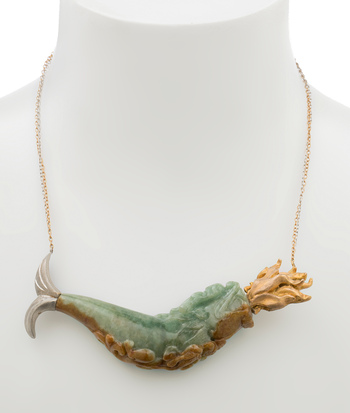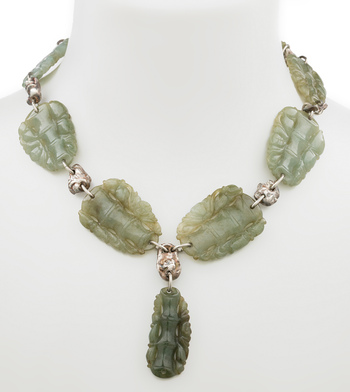Use of jade in jewelry.

The etymology of the term jade dates back to the Spanish conquest of South and Central America. It means flank stone, referring to a stone that the Spanish conquistadors brought from America, and to which healing properties were attributed for the liver, spleen and kidneys. It is a stone to which metaphysical qualities have always been attributed.
It is interesting to differentiate between the different types and qualities, being the jadeite variety the purest and most translucent of the typologies and also the most appreciated in jewelry. It comes in different colors, of which the deep green is the most coveted, if it has a greasy luster. Nephrite is somewhat more opaque, but shows a beautiful appearance, softer and with a wider range of colors offering a vitreous luster. There is also a lower quality industrial jade with a color enhancement treatment.
As a symbol of yang, jade is endowed with solar, imperial and indestructible qualities, hence its important role in archaic China. In the social order, it embodies sovereignty and power, procures the regeneration of the body, ensures immortality and also plays an important role in funerary practices.
In other ancient cultures, jade has also played a fundamental role with philosophical and religious meanings, as in the Mesoamerican cultures of the Olmec and Maya. The Maori people have used and venerated jade since its origins, using it in their jewelry and ornaments.
Except in Russia, jade has rarely been used in European jewelry before the art deco era. In Paris, Chinese art became more accessible with the creation of the Musée Guimet in 1889 and the Musée Cernuschi in 1898. Louis Cartier and his favorite designer, Charles Jacqueau, spent a lot of time in museums in search of inspiration. Oriental and Far Eastern arts, at that time, were for them the essence of modernity. Cartier was the pioneer in Art Deco design and introduced jadeite as early as 1913.
Subsequently, the use of jade became widespread in the 1920s, the golden age of jade in Western jewelry. Artists and jewelers were inspired by exoticism and the Far East was the source from which they all drank. After World War I, people needed to dream and the Roaring Twenties saw a fascination with Chinese art. According to French fashion magazines of the time, there was an obsession with China in all domains of taste: Parisian ladies started playing mahjong and adopting Pekingese dogs, home decoration and fashion were inspired by Chinese art, Chinese-themed costume balls were very popular…. Roger & Gallet launched a fragrance called Jade in a bottle shaped like a Chinese flask. Dealers specializing in Asian art established businesses in Paris and the advertisements of the Chinese antique dealer CT Loo offered “jade and hard stones, imported directly for jewelry”. The magazine “Femina”, a French magazine of the early 20th century, considered jade a valuable gemstone.
Cartier used ancient pieces of Chinese jade to create modern jewelry or precious objects. Many examples are preserved in his collection, such as jade hairpins turned into letter openers, jade snuff boxes that became perfume bottles, jade screens used in clocks, etc. These antique jades were part of the “stock des apprêts”, a collection of antique gems and objects of various provenance chosen by Louis Cartier for their beauty and preserved to create new pieces.
After the 1930s, jade fell into disuse in Western jewelry but interest in China returned in the 1970s and jade made a comeback. Inspired by art deco jewelry, especially Cartier, American jeweler David Webb produced many large pieces, including pieces with carved jade. Webb was known to buy antique jade from antique stores in New York. As Cartier did, what he bought and wore. He adapted to the unique shapes of the stones by designing “ad hoc” settings to contain the gems he worked with, as jewelry artists continue to do today.
At the beginning of this century, jade has re-emerged as the protagonist of a discreet but prestigious jewelry. It is a sign of a certain refinement and taste for distinction. Like Cartier, during the Art Deco period, French jeweler Thierry Vendome worked with antique jade pieces. During a trip to Beijing, he bought a 19th century nephrite carved bidisc with which he created a necklace that he sewed in several parts, set in silver and articulated by gold links, similar to the necklace we present in Setdart with jadeite plates.
Today, the market is looking for high quality jadeite, such as that found in the area of Myanmar bordering China. In recent years, production has declined and demand has almost tripled due to market access by Chinese buyers.
Even though both demands – Chinese and Western – have very different jewelry designs, the interest in jade has increased and is present in the fine jewelry of both cultures.
This trend was reflected in the auction of the famous Hutton-Mdivani necklace in April 2014. This necklace belonged to heiress Barbara Hutton and is a wonderfully translucent green jadeite beaded piece with ruby, diamond and platinum clasp. It was auctioned at Sotherby’s Hong Kong, and fetched $27.44 million, a pricenever before achieved for a jadeite jewel. The buyer was the Maison Cartier, designers of the piece, and it was acquired to be part of the firm’s collection.
Beyond this anecdote, buying today jadeite of superior quality, with intense green color and without shades of blue and yellow, can be considered an interesting investment.

